Meet the Maker: Elizabeth Bryan
This Orangeville weaver expanded her repertoire by making an outdoor sport of dyeing silk scarves in the snow.
When I arrive at Elizabeth Bryan’s home, the textile artist is shovelling snow. I fear I’ve caught her early, in the middle of chores. But she’s merely gathering raw material for her latest creations. In addition to weaving colourful scarves and other textiles, Elizabeth specializes in ethereal watercolour-like silk scarves – scarves she buries in snow, which she then drizzles with dye, snow-cone style.
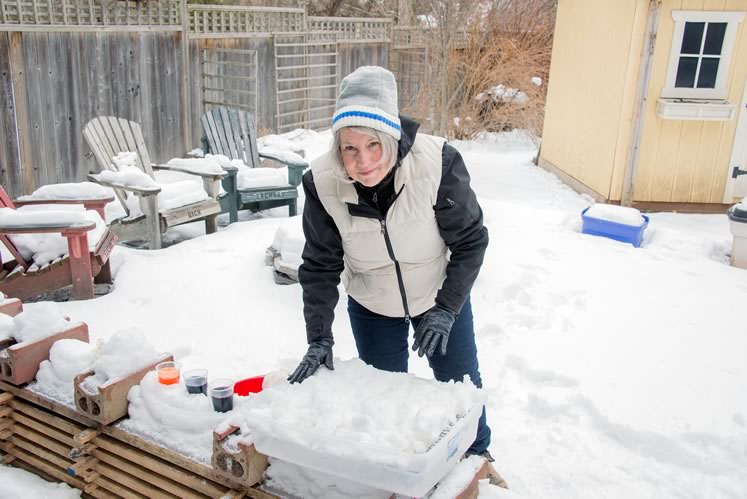
Textile artist Elizabeth Bryan creates her artfully abstract scarves by first covering them with snow and then drizzling dye over top. Photo by Pete Paterson.
We chat in her workspace, aka her Orangeville backyard. When the weather turns nasty, she moves her work into her three-season screened-in front porch. Elizabeth started weaving about 30 years ago and then picked up snow-dyeing around five years ago after discovering the process online. “I saw people using the snow-dyeing technique with yarn, a material I’m familiar with from weaving,” Elizabeth says. “It looked fun and spontaneous – with snow you can’t be precise – so I decided to try, teaching myself.”
Indeed, snow-dyeing is almost the opposite of her weaving work for her Weaverbee Textiles line, in which she is in control of every detail down to each thread. Although Elizabeth means to try snow-dyeing yarn one day, she says, her current preferred media are the long, rectangular silk scarves I see fluttering on a line to dry. With ripples of orange, purple and pale blue running through them, each seems to have its own intriguing personality.
The process begins with “scouring,” a term for the process of prepping the fabric by washing away natural residues or oils left from the manufacturing process. Elizabeth combines soda ash (sodium carbonate, the main ingredient in washing soda) and water, soaking the scarves in the mixture. After gently squeezing out the liquid, she lays out the scarf on an old cooling rack resting in a large shallow plastic tub. “I pick a pattern that suits my fancy that day,” she says. “Sometimes the scarves are scrunched up, other times they’re flat.” She covers the scarf completely with snow. I shiver watching the process. You need to be cold-tolerant to pursue this craft.
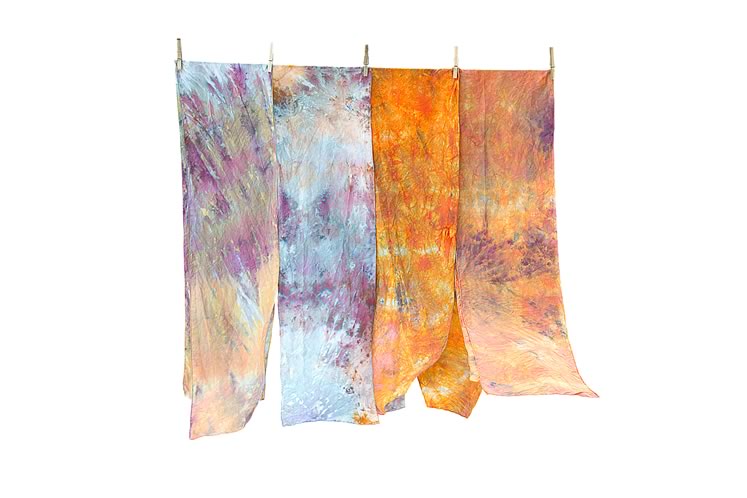
Snow-dyed scarves drying on a clothesline. Photo by Pete Paterson.
Colour mixing comes next. Elizabeth uses a commercial dye called Procion MX in powder form. It’s a fibre-reactive dye that bonds with the silk to create light washes of colour – as opposed to other types which provide deeper hues. She mixes a bit of the dye with more soda ash, which used at this stage helps the colour adhere to the silk. Then she pours the liquid over the snow. Today it’s an abstract mix of purple, blue and orange. “I use the colour palette that appeals to me that day,” Elizabeth says. “It can be two, three or four colours at once – it’s really trial and error to learn which colours work well together. You can’t control how the colours either break up or meld.”
The dye seeps through the snow and eventually pools under the rack. Elizabeth waits until all the snow has melted, usually about 24 hours, depending on the air temperature. As it melts, the colours she’s chosen blend into new shades or break down into their component shades. Because of this tendency, the colour blue, for instance, is the hardest colour to achieve, she says. “It breaks down into its components of green, yellow and even red.”
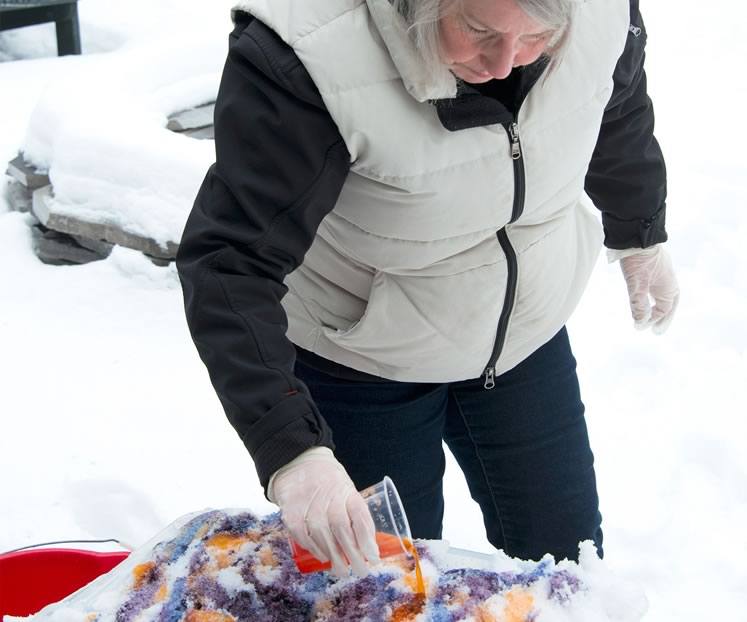
Elizabeth pours orange, blue and purple dye over a layer of snow covering a silk scarf. Photo by Pete Paterson.
After the snow has melted, Elizabeth rinses the scarves with tepid water to remove excess dye and snow bits, then hangs them to dry. After a steam iron, it is time for the reveal. “If there are any duds, I can always over-dye them, basically a do-over,” says Elizabeth. “More often than not I love the unique combinations and wish I could repeat them.” Two favourites come to her mind. She achieved that elusive blue in a piece created for the Fire and Ice Festival at the Alton Mill Arts Centre a few years ago. Another cherished piece exhibited an “unexpected flow” of colours running together. Elizabeth’s mother possesses that special creation.
Elizabeth searches out potential colour combinations everywhere from her own stash of yarn (she confesses to having quite a lot) to paintings she admires. She cites the soft, impressionist palette of 19th-century painter Claude Monet as one of her sources of inspiration. “I am extremely influenced by colour – just check out my social media pages and you’ll see my favourite hashtag, #colourismyjam.”
More Info
Visit weaverbee.ca or see Elizabeth’s work at the Holiday Treasures show and sale at the Museum of Dufferin, December 1 to 12.
Related Stories
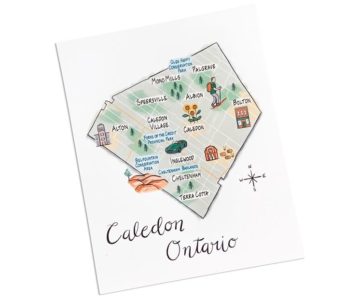
Local Buys: Winter 2021
Nov 29, 2021 | | Made in the HillsCozy knits, chic home upgrades and handcrafted kid presents.
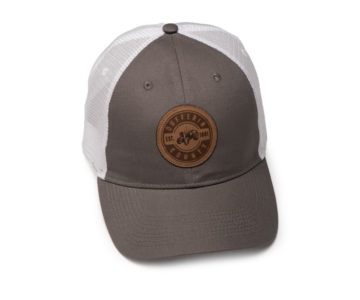
Local Buys: Autumn 2021
Sep 24, 2021 | | Made in the HillsHiking accessories, pressed flowers and a nod to local farming culture.
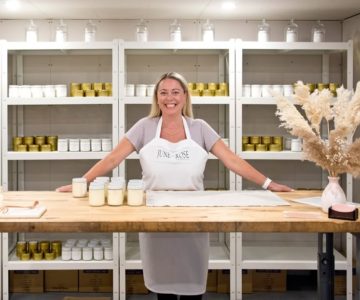
Meet the Maker: Melissa Lester of June + Rose Candle Co.
Sep 24, 2021 | | Made in the HillsHow the Caledon clothing retailer changed course to become a candlemaker with a knack for irresistible aromas.
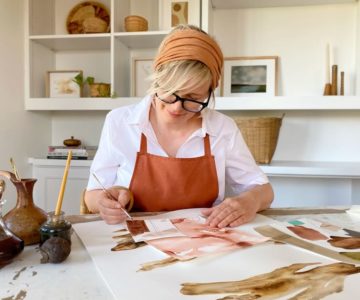
Meet the Maker: Melissa Jenkins
Jun 22, 2021 | | Made in the HillsNatural inks made from foraged plants gave this artist a way to heal her body and share her passion for the outdoors.
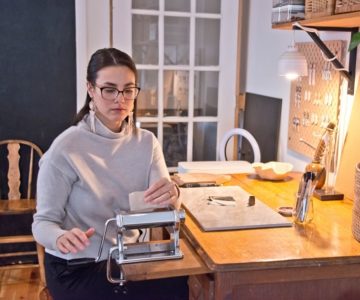
Meet the Maker: Kristin Evensen
Mar 31, 2021 | | Made in the HillsThis Orangeville artist strings together her Anishnaabe heritage and contemporary design in every pair of earrings she makes.
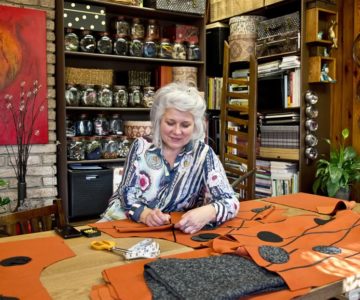
Meet the Maker: Cristina Repanovici
Nov 24, 2020 | | Made in the HillsHow a designer found her groove in Caledon East by offering one-of-a-kind jewelry pieces and sculptural clothing creations.






